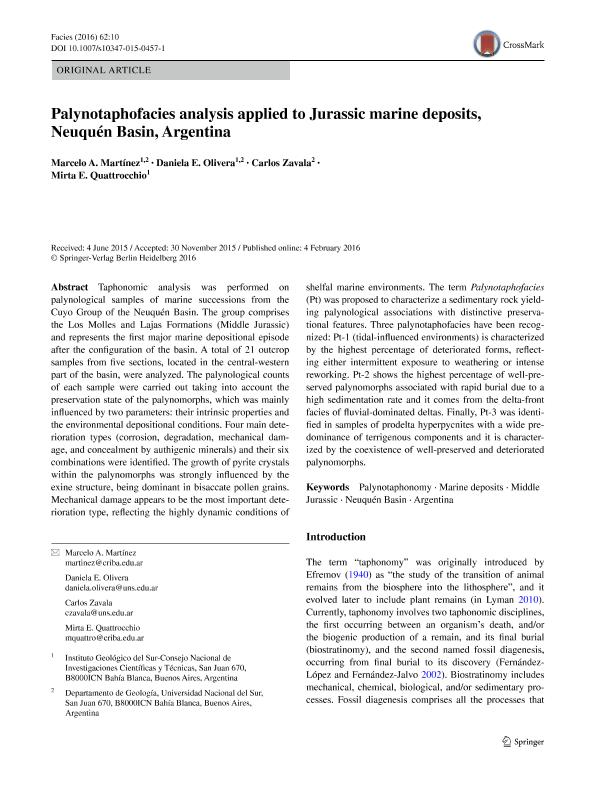Artículo
Palynotaphofacies analysis applied to Jurassic marine deposits, Neuquén Basin, Argentina
Martinez, Marcelo Adrian ; Olivera, Daniela Elizabeth
; Olivera, Daniela Elizabeth ; Zavala, Carlos Alberto
; Zavala, Carlos Alberto ; Quattrocchio, Mirta Elena
; Quattrocchio, Mirta Elena
 ; Olivera, Daniela Elizabeth
; Olivera, Daniela Elizabeth ; Zavala, Carlos Alberto
; Zavala, Carlos Alberto ; Quattrocchio, Mirta Elena
; Quattrocchio, Mirta Elena
Fecha de publicación:
04/2016
Editorial:
Springer
Revista:
Facies
ISSN:
0172-9179
Idioma:
Inglés
Tipo de recurso:
Artículo publicado
Clasificación temática:
Resumen
Taphonomic analysis was performed on palynological samples of marine successions from the Cuyo Group of the Neuquén Basin. The group comprises the Los Molles and Lajas Formations (Middle Jurassic) and represents the first major marine depositional episode after the configuration of the basin. A total of 21 outcrop samples from five sections, located in the central-western part of the basin, were analyzed. The palynological counts of each sample were carried out taking into account the preservation state of the palynomorphs, which was mainly influenced by two parameters: their intrinsic properties and the environmental depositional conditions. Four main deterioration types (corrosion, degradation, mechanical damage, and concealment by authigenic minerals) and their six combinations were identified. The growth of pyrite crystals within the palynomorphs was strongly influenced by the exine structure, being dominant in bisaccate pollen grains. Mechanical damage appears to be the most important deterioration type, reflecting the highly dynamic conditions of shelfal marine environments. The term Palynotaphofacies (Pt) was proposed to characterize a sedimentary rock yielding palynological associations with distinctive preservational features. Three palynotaphofacies have been recognized: Pt-1 (tidal-influenced environments) is characterized by the highest percentage of deteriorated forms, reflecting either intermittent exposure to weathering or intense reworking. Pt-2 shows the highest percentage of well-preserved palynomorphs associated with rapid burial due to a high sedimentation rate and it comes from the delta-front facies of fluvial-dominated deltas. Finally, Pt-3 was identified in samples of prodelta hyperpycnites with a wide predominance of terrigenous components and it is characterized by the coexistence of well-preserved and deteriorated palynomorphs.
Palabras clave:
Argentina
,
Marine Deposits
,
Middle Jurassic
,
Neuquén Basin
,
Palynotaphonomy
Archivos asociados
Licencia
Identificadores
Colecciones
Articulos(INGEOSUR)
Articulos de INST.GEOLOGICO DEL SUR
Articulos de INST.GEOLOGICO DEL SUR
Citación
Martinez, Marcelo Adrian; Olivera, Daniela Elizabeth; Zavala, Carlos Alberto; Quattrocchio, Mirta Elena; Palynotaphofacies analysis applied to Jurassic marine deposits, Neuquén Basin, Argentina; Springer; Facies; 62; 2; 4-2016; 1-16
Compartir
Altmétricas



